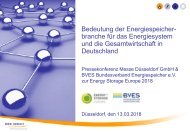Renewable Energy – Solutions for application in the communal energy infrastructure
This brochure contains a selection of successful renewable energy solutions suitable for a range of applications for local and national municipalities and economies. The main energy end-use sectors and the current state of the energy transition are briefly explained to provide readers with an understanding of the transformation of the greater energy system. The renewable energy technology options are explained, including their relevance and applications for municipalities. Finally, a selection of exemplary projects that have been successfully implemented in Europe, the Russian Federation and Central Asia, are included to demonstrate real applications and use-cases for renewable solutions. Renewable energies are cheap, clean and versatile.
This brochure contains a selection of successful renewable energy solutions suitable for a range of applications for local and national municipalities and economies. The main energy end-use sectors and the current state of the energy transition are briefly explained to provide readers with an understanding of the transformation of the greater energy system. The renewable energy technology options are explained, including their relevance and applications for municipalities. Finally, a selection of exemplary projects that have been successfully implemented in Europe, the Russian Federation and Central Asia, are included to demonstrate real applications and use-cases for renewable solutions. Renewable energies are cheap, clean and versatile.
You also want an ePaper? Increase the reach of your titles
YUMPU automatically turns print PDFs into web optimized ePapers that Google loves.
HYDROPOWER |<br />
15<br />
The Francis turb<strong>in</strong>e is a universally applicable water turb<strong>in</strong>e, <strong>in</strong><br />
which <strong>the</strong> impeller is radially imp<strong>in</strong>ged from <strong>the</strong> outside.<br />
The Kaplan turb<strong>in</strong>e is an axial-flow water turb<strong>in</strong>e and is used <strong>in</strong><br />
run-of-river power plants.<br />
Possible <strong>application</strong>s and benefits <strong>for</strong> municipalities:<br />
Small hydroelectric power plants with a capacity of<br />
up to approx. 25 megawatts support a wide range of<br />
potential <strong>application</strong>s:<br />
• Power supply to remote villages and regions<br />
• Improv<strong>in</strong>g <strong>in</strong>frastructure <strong>in</strong> already developed areas<br />
• Cover<strong>in</strong>g <strong>the</strong> base load <strong>in</strong> <strong>the</strong> electricity grid<br />
• Secur<strong>in</strong>g <strong>the</strong> supply of electrical <strong>energy</strong><br />
• Stabilisation of <strong>the</strong> groundwater level<br />
• Reduction of climate-damag<strong>in</strong>g emissions<br />
Functional pr<strong>in</strong>ciple and design<br />
Small hydroelectric power plants are usually run-ofriver<br />
(RoR) power plants. They use <strong>the</strong> hydraulic <strong>energy</strong><br />
of flow<strong>in</strong>g water and cont<strong>in</strong>uously convert it <strong>in</strong>to electricity.<br />
Pumped storage plants are to be dist<strong>in</strong>guished<br />
from this. These store <strong>the</strong> water <strong>in</strong> a reservoir and<br />
generate electrical <strong>energy</strong> when needed.<br />
A run-of-river power plant works as follows:<br />
Run-of-river or what are also known as ‘diversion’<br />
power plants may also be contructed to channel or divert<br />
water to <strong>the</strong> power plant via an additional watercourse<br />
alongside <strong>the</strong> weir and ma<strong>in</strong> water body. The<br />
goal is to achieve a greater gradient <strong>in</strong> order to achieve<br />
more <strong>energy</strong>.<br />
Ano<strong>the</strong>r important component <strong>in</strong> <strong>the</strong> hydro electric<br />
power plant are <strong>the</strong> rakes. The metal grilles possess<br />
a dual function. Firstly, <strong>the</strong>y protect <strong>the</strong> turb<strong>in</strong>e from<br />
damage caused by float<strong>in</strong>g refuse <strong>–</strong> such as branches<br />
and rubbish. Secondly, <strong>the</strong> small rake distances prevent<br />
fish from enter<strong>in</strong>g <strong>in</strong>to <strong>the</strong> power plant. The mechanical<br />
barrier moves <strong>the</strong> fish away from <strong>the</strong>ir migratory path<br />
with <strong>the</strong> ma<strong>in</strong> current. In order to ensure <strong>the</strong> cont<strong>in</strong>uity<br />
of flow<strong>in</strong>g waters, plant operators often build devices<br />
known colloquially as “fish ladders” at <strong>the</strong> edge of <strong>the</strong><br />
watercourse.<br />
Run-of-river power plants are particularly suitable <strong>for</strong><br />
watercourses with high flow velocities. They achieve<br />
very high efficiencies of up to roughly 90 per cent.<br />
The water may first be dammed up at a wier or dam<br />
wall but is not always required. The water upstream of<br />
<strong>the</strong> power plant (headwater) is higher than <strong>the</strong> water<br />
downstream of <strong>the</strong> power plant (tailwater). The steeper<br />
<strong>the</strong> gradient, <strong>the</strong> greater <strong>the</strong> amount of <strong>energy</strong> generated.<br />
The headwater is fed <strong>in</strong>to <strong>the</strong> power plant to <strong>the</strong> turb<strong>in</strong>e.<br />
This drives a generator that subsequently generates<br />
electrical <strong>energy</strong> (electricity) from <strong>the</strong> mechanical<br />
<strong>energy</strong>. After power generation, <strong>the</strong> tail water flows out<br />
of <strong>the</strong> plant.








